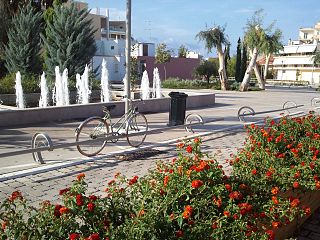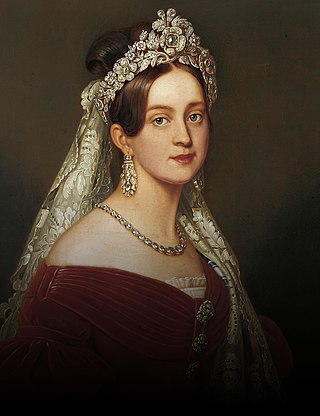
Amaliada is a town and a former municipality in northwestern Elis, West Greece, Greece. Since the 2011 local government reform it is part of the municipality Ilida, of which it is the seat and a municipal unit. The municipal unit has an area of 251.945 km2. In 2011, the municipal unit had 28,520 inhabitants, of whom 16,763 lived in the town of Amaliada. It is near the archaeological site of Elis, the city-state whose territory was the site of the ancient Olympic Games. It is situated in the plains of Elis, 6 km from the Ionian Sea. It is 10 km southeast of Gastouni, 16 km northwest of Pyrgos and 60 km southwest of Patras.

Amalia of Solms-Braunfels was Princess of Orange by marriage to Frederick Henry, Prince of Orange. She acted as the political adviser of her spouse during his reign, and acted as his de facto deputy and regent during his infirmity from 1640 to 1647. She also served as chair of the regency council during the minority of her grandson William III, Prince of Orange from 1650 until 1672. She was the daughter of count Johann Albrecht I of Solms-Braunfels (1563-1623) and countess Agnes of Sayn-Wittgenstein (1568-1617).

Catharina-Amalia, Princess of Orange is the heir apparent to the throne of the Kingdom of the Netherlands, which consists of the constituent countries of Aruba, Curaçao, the Netherlands, and Sint Maarten.

Maria Amalia Teresa of Naples and Sicily was Queen of the French by marriage to Louis Philippe I, King of the French. She was the last queen of France.

Amália da Piedade Rebordão RodriguesGCSE, GCIH, better known as Amália Rodrigues or popularly as Amália, was a Portuguese fadista and actress.
Anna Amalia or Anna Amalie may refer to:

She Loves Me is a musical with a book by Joe Masteroff, music by Jerry Bock, and lyrics by Sheldon Harnick.

Amalia of Oldenburg was a Bavarian princess who became Queen of Greece from 1836 to 1862 as the wife of King Otto Friedrich Ludwig. She was loved widely by the Greeks due to her patriotic love for the country and her beauty. During her tenure as queen, she was dedicated to social improvement and the founding of many gardens in Athens, and she was the first to introduce the worldwide Christmas tree to Greece.

The Robbers is the first drama by German playwright Friedrich Schiller. The play was published in 1781 and premiered on 13 January 1782 in Mannheim, Germany, and was inspired by Leisewitz' earlier play Julius of Taranto. It was written towards the end of the German Sturm und Drang movement, and many critics, such as Peter Brooks, consider it very influential in the development of European melodrama. The play astounded its Mannheim audience and made Schiller an overnight sensation. It later became the basis for Verdi's opera of the same name, I masnadieri.

Ferdinand I was Duke of Parma, Piacenza and Guastalla from his father's death on 18 July 1765 until he ceded the duchy to France by the Treaty of Aranjuez on 20 March 1801. He was a member of the Spanish House of Bourbon.

Maria Amalia of Saxony was born a princess of Poland and Saxony, and became Queen of Naples and Sicily from 1738 until 1759, and then Queen of Spain from 1759 until her death in 1760 by marriage to Charles III of Spain. The arranged marriage produced many children who survived into adulthood, including Charles IV of Spain. A popular consort, she oversaw the construction of the Caserta Palace outside Naples as well as various other projects, and she is known for her influence upon the affairs of state.

Maria Amalia, Duchess of Parma was Duchess of Parma, Piacenza and Guastalla by marriage to Ferdinand, Duke of Parma. She was born an archduchess of Austria as the daughter of Empress Maria Theresa and Emperor Francis I.

Polkagris is a Swedish stick candy that was invented in 1859 by Amalia Eriksson in the town of Gränna, Sweden. It remains a well-known albeit old-fashioned candy in Sweden, often sold at fairs, Christmas markets, and the like. It is still closely associated with Gränna. The traditional polkagris candy stick is white and red, and is peppermint-flavoured.

Amalia is a female given name, derived from the Germanic word amal, meaning "work, activity", specifically the woman's name Amalberga. Its popularity is attributed to the Belgian Saint Amalberga of Maubeuge. The origins of the name Amalia have often been associated with those of Emilia and Emily, both of which in fact originate from the Latin nomen Aemilia, or with Amalthea, which originated from the Greek name "tender goddess". In Greece, the name is celebrated on 10 July in honour of Saint Amalia.
Amalia K. Amaki is an African-American artist, art historian, educator, film critic and curator who recently resided in Tuscaloosa, Alabama, where she was Professor of Modern and Contemporary Art at the University of Alabama at Tuscaloosa from 2007 to 2012.

Amalia Fuentes was a Filipino actress who reigned as a "Movie Queen" in the 1960s and 1970s. She was once dubbed as the "Elizabeth Taylor of the Philippines". She was the aunt of actors Aga Muhlach and Niño Muhlach and the mother of actress Liezl Martinez. She was the first Filipino Lux Soap model.
The R504 is a Regional Route in South Africa that connects Pudimoe with Bothaville via Amalia, Schweizer-Reneke, Wolmaransstad and Leeudoringstad.
Gwendoline Joyce Lewis (1909–1967) was a South African botanist.















